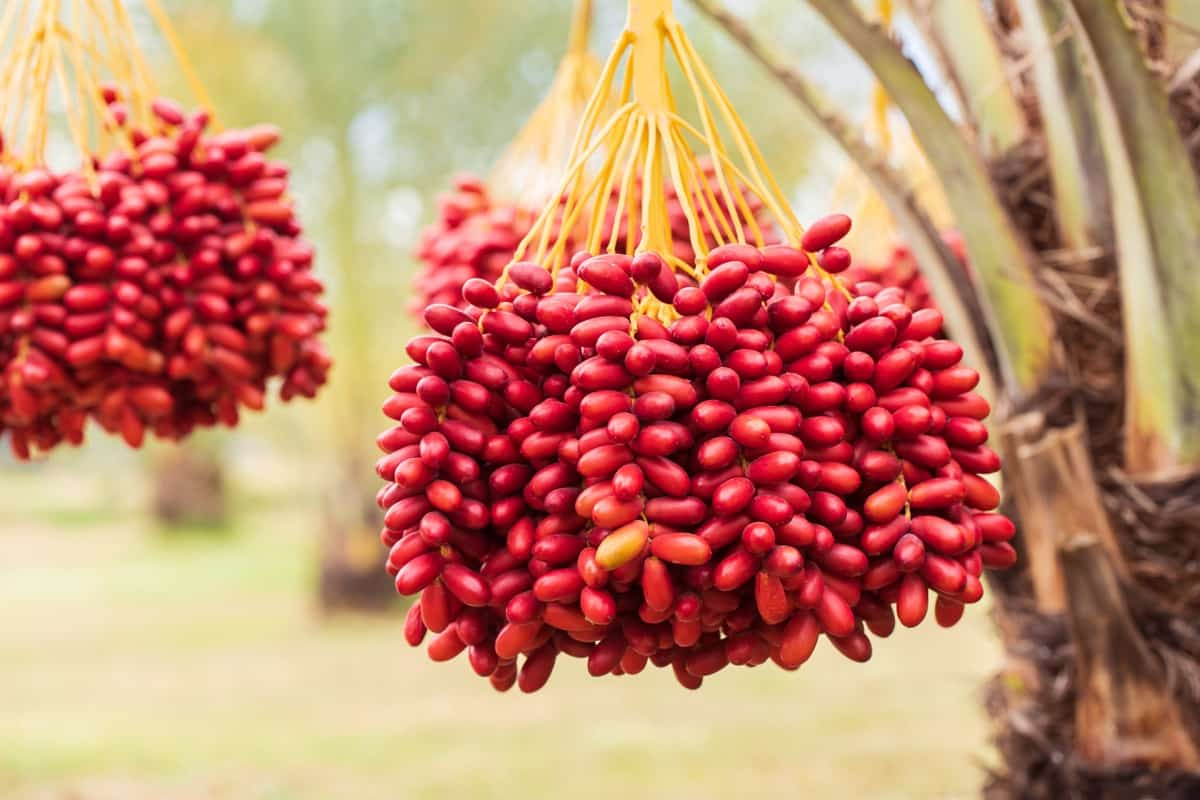
In India, date palm agriculture is practised in the coastal belt from Mandvi to Anjar in the districts of Kutch and Saurashtra of Gujarat. Rajasthan, Tamil Nadu, and Kerala are some of the states that produce it. Date palm is the major crop of Kutch in India.
One of the most successful farmers of Bhuj in Gujarat has adopted Israeli Technology for date palm cultivation. The origin of date palms is unknown. Legend says it has been cultivated since 4000 BC. People of the Indus Valley civilisation and the Middle East consumed it as a basic food.
Date Palm Varieties
Globally, more than three thousand species of date palm are found. But not all are commercially grown.
- Soft-Fleshed: Halawy, Medjoot, Shamran (sayer), Hayani, Khadrawy, and Saidy.
- Dry and Semi-Dry Fleshed: Zahidi, Thoory, Noor, Deglet, and Dayari.
- Non-Astringent: Halawy, Barhee, Chip Chap (Kip Kap), Bureim, Shaker, and Shahaani.
- Chaharamaking: Khadrawy, Zahidi, and Medjoot.
Climate Requirement
The climate is especially critical to date palm production. It requires a hot summer, a mild winter, no rainfall during flowering and fruiting, low relative humidity, and much sunshine. The wild dates grow as high as 1500 metres. The date palm is among the greatest crops in the Middle Eastern deserts. An optimal flowering and fruiting temperature is above 70 degrees Fahrenheit.
Soil Requirement
Date palm cultivation has a broad spectrum of suitable soils. Sandy loam and well-drained soils, without hardpan below within the range of 60-90cm and having pH between 8-10. Mahindra Tractor can facilitate soil preparation for date palm cultivation. Date palm cultivation can be practiced in saline and alkaline soil, but the growth and yield are affected.
Propagation Method
Off-shoots or suckers are the most prevalent mode of spread. At the base of the mother tree, the offshoots should be plucked. Four-five years after planting, you have to cut the sucker. In the fourth and tenth year of the tree, you can get 9-20 suckers weighing 9-15 kg. One date tree has a productive life of 10-25 offshoots. This is a time-consuming multiplication process that gives a high yield.
- Seed: The method of propagation, in turn, is not followed by the farmers as the fruits are of inferior quality. Most of the fruits give rise to non-bearing males, which cannot be used for propagation.
- Tissue Culture: This method causes rapid propagation of date palm.
Irrigation Requirement
Immediate irrigation is required after plantation. Drought and over-irrigation do not have an adverse effect on date palm production. Both, though, are hazardous. The date palm likes a constant level of moisture in the soil. Contrastingly, waterlogged soil should never be used. Irrigation is not required during the monsoon. The flood should be drained if it occurs.
In areas with high water tables, 5-6 irrigations per year are enough. Soil should be irrigated soon after planting. Once the off-shoots appear, you can cut down on the irrigation frequency. Top dressing of dried leaves and grasses is a good suggestion. It helps in water retention in the soil, especially in arid and semi-arid environments.
Intercropping
Date palm plants are very long-lived. It is easy to intercrop pulses like gram, peas, lentils, and vegetables. Pomegranate and papaya can be grown, too. While intercropping, ensure you have other irrigation and nutrients prepared.
Pruning
Date palm cultivation requires pruning in order to ensure an adequate number of green leaves for good growth and yield. Scientists predict that the bearing stage of the tree will have 75-100 leaves.
Thus, during the first 4-5 years, no pruning is needed as only 20 leaves are produced per year. In order to enhance fruit quality, it is necessary to maintain a proper leaf-bunch ratio. If the ratio is high, the humidity is high, and in such conditions, Black disease in dates begins to develop.
Pollination
In nature, date palm trees are dioecious and heavily cross-pollinated. All it takes to pollinate 100 female plants is 5-10% of the male plants. In commercial date palm production, the pollination is either manual or mechanical. Three male flower strands are introduced into each female flower strand.
It is also a necessary agriculture process in the cultivation of date palm since pollination affects the size and quality of the dates palm fruits besides the timing of ripening.
Fertilizers
The rainfed areas require 30- 40 kg FYM and 200 g of Nitrogen, Phosphorus, and Potassium (NPK) per tree. In irrigated areas, 50-60 kg FYM and 200 g of NPK are needed per tree. All of FYM, half of N and full of P and K should be applied in September-October. Apply the rest of N in January-February. Rotting leguminous cover crops can be green-manured.
Harvesting
Harvesting is done depending on the growth and ripening stages, as dates are consumed at various levels of maturity. You can harvest the fruit at the following ripening stages:
- While the fruit is still immature and green, known as Gandora or Kimri.
- As the fruit attains its final size and changes colour from green to red or yellow, also called Dora or Khalal.
- When the fruit tip starts to soften, it is referred to as Dang or Rutab.
- When the fruit is fully ripe and dry enough to be stored without rotting, it is known as Pind or Tamar. Moreover, considering Mini Tractor Price in India could optimise farming operations.
Yield
The Date palm tree normally starts to flower in its 4th year. It has a moderate yield of up to 5000kg/ha from the 5th year when it is well-tended.
Average yield:
- A 10-year-old date palm tree produces 50-60 kg fruits annually.
- The yield from a 15-year-old date palm tree is 80-200 kg of fruits per annum.
- Yield is affected by variety, soil, area and cultivation methods.
Storage
The Khalal stage is the last stage of the dates’ development, and it possesses a high percentage of water content, ranging from 70% to 80%. A date is usually picked at this stage. They have a poor shelf life at room temperature.
The only way to maintain its quality is to keep it cold. On the other hand, to maintain their freshness and crispiness, they have to be sold out as soon as possible. Otherwise, they need to be treated and turned into value-added products. Dried dates can be stored for one year.








